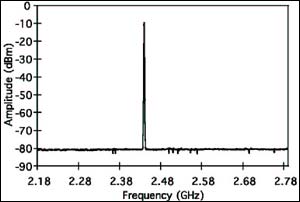Microwave ovens that won’t mess with your cordless phone and wireless computer

Microwave spectrum of new magnetron from the University of Michigan
45th Annual Meeting of the Division of Plasma Physics
A new invention removes noisy microwave signals from microwave ovens and prevents them from interfering with cordless phones and wireless computer networks. The new technology, developed by plasma physicists at the University of Michigan, is also expected to lead to more efficient microwave ovens, with little or no addition to the ovens’ cost.
Microwave ovens heat food by emitting microwaves from a device called a magnetron. Those microwaves then heat and cook the food. One problem with magnetrons is that they emit extra “noisy” microwaves at frequencies that can interfere with other devices. Microwave ovens share an unlicensed part of the microwave frequency band with cordless phones and computer communications systems such as Bluetooth and IEEE 802.11b,g (the standards for wireless networks).
The new magnetron produces a “clean” signal with essentially zero emissions apart from the 2.45 GHz frequency it is designed to emit. The secret is in arranging the magnetic fields in the magnetron just the right way. Fortunately, this configuration can be implemented very inexpensively in practically all magnetrons of different makes, ages and power outputs, making it feasible for use in consumer microwave ovens.
Contacts
Ron Gilgenbach, Univ of Michigan, 505-842-1234, rongilg@umich.edu
Y. Y. Lau, Univ of Michigan, 505-842-1234, yylau@umich.edu
Media Contact
All latest news from the category: Process Engineering
This special field revolves around processes for modifying material properties (milling, cooling), composition (filtration, distillation) and type (oxidation, hydration).
Valuable information is available on a broad range of technologies including material separation, laser processes, measuring techniques and robot engineering in addition to testing methods and coating and materials analysis processes.
Newest articles

A universal framework for spatial biology
SpatialData is a freely accessible tool to unify and integrate data from different omics technologies accounting for spatial information, which can provide holistic insights into health and disease. Biological processes…

How complex biological processes arise
A $20 million grant from the U.S. National Science Foundation (NSF) will support the establishment and operation of the National Synthesis Center for Emergence in the Molecular and Cellular Sciences (NCEMS) at…

Airborne single-photon lidar system achieves high-resolution 3D imaging
Compact, low-power system opens doors for photon-efficient drone and satellite-based environmental monitoring and mapping. Researchers have developed a compact and lightweight single-photon airborne lidar system that can acquire high-resolution 3D…





















